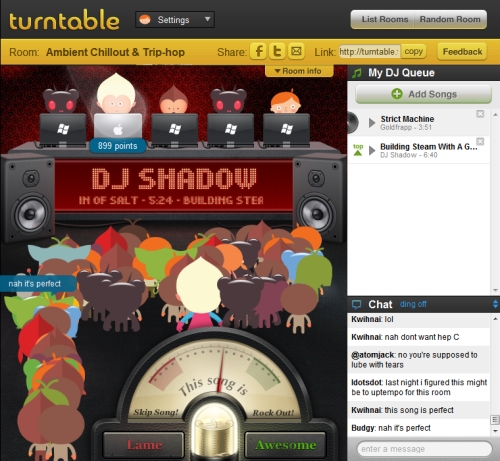Turntable.fm – Brought To You By The Founders Of Stickybits

In one of the more bizarre (from my perspective) changes in a company’s business model comes Turntable.fm. Remember Stickybits – the company that allowed you to place a bar code on any object and ‘internet-ize’ it? Well, according to The Next Web, the founders have made a huge right hand turn and shifted their attention to a ‘social listening’ project where each of us has a hand in the music that is being played.
The invite list is ‘sort of’ exclusive. You can only sign up if a friend of yours on Facebook is currently a member. Not hard for most of you with more than a hundred or so friends. Upon entry, you can step up to the podium and spin your music against 4 other ‘Social DJs’. The audience decides which of the DJs lays down the next track through a simple voting system.
What’s brilliant about this is a combination of social interaction, visual simplicity (fun anime characters right down to the PC vs. Mac DJs), and the ability to hear a variety of music you might not otherwise be exposed to if you were only choosing the tracks in a particular genre (The Next Web calls this out under ‘Music Discovery’ – dubbing it a ‘more social’ version of Pandora or Last.fm – spot on, in my opinion). Even better is the fact that I get to ‘save’ tracks that I’m interested in by adding them to my Turntable Queue, Last.fm, Spotify, or iTunes. +1 Turntable – thank you for not making this a walled garden.
I’ve found myself spending more time here than on my other go-to music services in the last few weeks, and am finding that I’m not the only one enjoying the addition of a new player based on my Facebook feed. With all of the social exposure that Turntable is experiencing, I’m anticipating that there will be a level of push back from the labels pertaining to rights of the tracks that are being shared (something Pandora is well versed in).
Big right hand turns don’t always pay off… In this case, I think the founders of Stickybits made a smart choice. They’ve created an ‘venue’ where the casual listener can discover new music, independent artists can use it as a platform to promote their own creations, and brands can host an experience within the environment connecting directly (in real time) with their consumers through a brand experience and group chat.
Looking forward to watching the service continue to evolve and make the social music landscape even more competitive.
 I’ve been thinking a lot lately about the connection between my digital world and the physical world. I spend a lot of time in both (with my job being the forcing function for the former) and have often wondered how much cross over there really is in terms of the activities that are being done. What has risen to the surface for me lately is the notion of ‘tagging’. Think of it in terms of Facebook. I take thousands of photos every year – of places, people, events, objects, animals, and simple moments in time that I want to capture. When I post those photos – either to my Facebook account or my Flickr account, I am usually pretty diligent about ‘tagging’ the important objects (human or non human) that are present in each photo. That creates a digital, track-able, trail that can be shared with those that I feel would like to participate in the experience. Our social networking personas are full of ‘tagged’ content. From a simple statement on Twitter to a photo on Facebook to a mention in a blog post.
I’ve been thinking a lot lately about the connection between my digital world and the physical world. I spend a lot of time in both (with my job being the forcing function for the former) and have often wondered how much cross over there really is in terms of the activities that are being done. What has risen to the surface for me lately is the notion of ‘tagging’. Think of it in terms of Facebook. I take thousands of photos every year – of places, people, events, objects, animals, and simple moments in time that I want to capture. When I post those photos – either to my Facebook account or my Flickr account, I am usually pretty diligent about ‘tagging’ the important objects (human or non human) that are present in each photo. That creates a digital, track-able, trail that can be shared with those that I feel would like to participate in the experience. Our social networking personas are full of ‘tagged’ content. From a simple statement on Twitter to a photo on Facebook to a mention in a blog post.